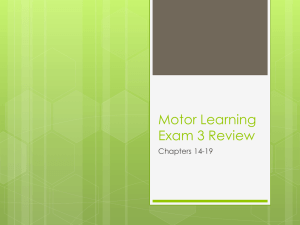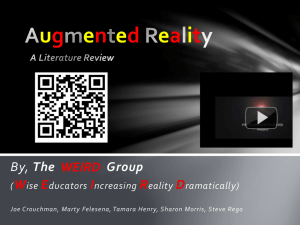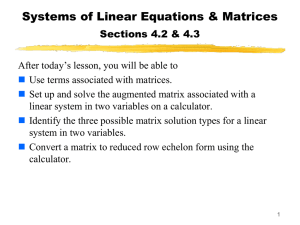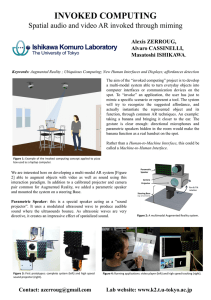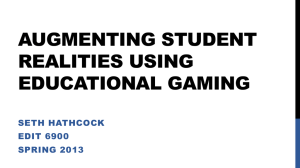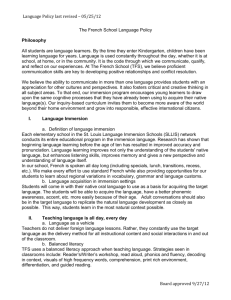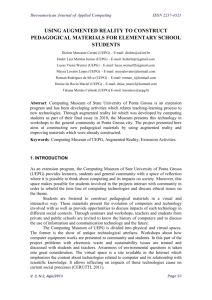roadmap TC2.4 UPS
advertisement
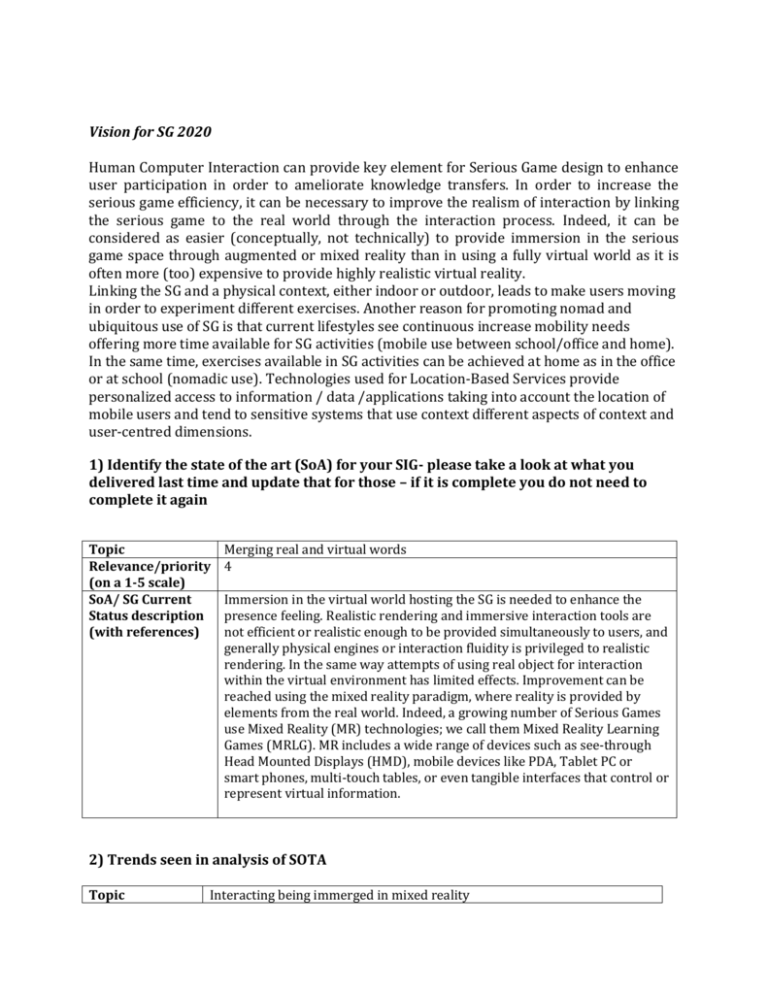
Vision for SG 2020 Human Computer Interaction can provide key element for Serious Game design to enhance user participation in order to ameliorate knowledge transfers. In order to increase the serious game efficiency, it can be necessary to improve the realism of interaction by linking the serious game to the real world through the interaction process. Indeed, it can be considered as easier (conceptually, not technically) to provide immersion in the serious game space through augmented or mixed reality than in using a fully virtual world as it is often more (too) expensive to provide highly realistic virtual reality. Linking the SG and a physical context, either indoor or outdoor, leads to make users moving in order to experiment different exercises. Another reason for promoting nomad and ubiquitous use of SG is that current lifestyles see continuous increase mobility needs offering more time available for SG activities (mobile use between school/office and home). In the same time, exercises available in SG activities can be achieved at home as in the office or at school (nomadic use). Technologies used for Location-Based Services provide personalized access to information / data /applications taking into account the location of mobile users and tend to sensitive systems that use context different aspects of context and user-centred dimensions. 1) Identify the state of the art (SoA) for your SIG- please take a look at what you delivered last time and update that for those – if it is complete you do not need to complete it again Topic Relevance/priority (on a 1-5 scale) SoA/ SG Current Status description (with references) Merging real and virtual words 4 Immersion in the virtual world hosting the SG is needed to enhance the presence feeling. Realistic rendering and immersive interaction tools are not efficient or realistic enough to be provided simultaneously to users, and generally physical engines or interaction fluidity is privileged to realistic rendering. In the same way attempts of using real object for interaction within the virtual environment has limited effects. Improvement can be reached using the mixed reality paradigm, where reality is provided by elements from the real world. Indeed, a growing number of Serious Games use Mixed Reality (MR) technologies; we call them Mixed Reality Learning Games (MRLG). MR includes a wide range of devices such as see-through Head Mounted Displays (HMD), mobile devices like PDA, Tablet PC or smart phones, multi-touch tables, or even tangible interfaces that control or represent virtual information. 2) Trends seen in analysis of SOTA Topic Interacting being immerged in mixed reality Related to SOA Description of trend (with references) Pervasive learning environments, CHI Physical immersion is a component needed for the emergence of the presence feeling. More than immersion in virtual environment, one of the new trends in HCI is to make a unique interactive universe mixing virtual and physical worlds seen as a global system. The objective of using Mixed Reality is clear: it is to anchor the knowledge of the learner in an authentic context. In contrast to a virtual world, the real world provides the learner creates knowledge appropriately to the real world. Mixed reality has already been exploited in learning or game fields, which use a wide range of devices mentioned in the SOA. For instance, Zuckerman et al. (2005) use bloc manipulation to teach abstract concepts to children while Liu et al. (2007) create a whole mixed reality class about solar system and plant lifecycle, using HMD to view digital elements and cups to manipulate the latter. As for Leitner, Koeffel & Haller, (2008) which introduce Tabletop gaming augmented with tangible objects. In spite of the huge possibilities brought by technology, most of MRLG use handheld mobile devices, including “Zoo scene investigators” (Perry et al. 2008), “Reliving the revolution” (Schrier 2006), “Mad City Mystery”(Squire et Jan 2007), “Playing with Fire(Power et al. 2010) and “Eduventure Game” (Ferdinand et al. 2005). Those learning games are all investigation-oriented situation in real places. The lack of diversity in MRLG can be explained by the innovative, unusual and non-mature aspect of mixed reality technologies. Moreover, creating a MRLG is long and difficult. Indeed, MRLG designers must use correctly a “new” technology, and at the same time create an engaging game with a good pedagogy on the learning subject MRLG designers justified the use of mixed reality technologies by motivational expectations (game mechanics, curiosity), active pedagogy through a better immersion in authentic context, or pedagogical expectations (better learning transfer). Only qualitative outcomes have appeared, but they were globally positive learning outcomes and strong implication from the learners/gamers, who had fun. Implication: Mixed Reality Learning Games (MRLG) combine the assets of game-based learning and the new perspectives provided by mixed reality. They offer real benefits for teaching: they enable active pedagogy trough the physical immersion of learners, “in situ” information while practicing and authentic context. Besides, the learner is strongly implicated and has a better motivation. As a result, MR devices are likely to be more used in the future, as soon as the designers will know how to use the technology efficiently along with pedagogy and coherent game mechanics. Ferdinand, P., S. Müller, T. Ritschel, et U. Wechselberger. 2005. « The Eduventure–A new approach of digital game based learning combining virtual and mobile augmented reality games episodes ». In Pre-Conference Workshop « Game based Learning » of DeLFI 2005 and GMW 2005 Conference, Rostock. Vol. 13. Leitner, Jakob, Christina Koeffel, et Michael Haller. 2008. « Bridging the gap between real and virtual objects for tabletop games ». The International Journal of Virtual Reality 7 (4): 33‑40. Liu, Wei, Adrian David Cheok, Charissa Lim Mei-Ling, et Yin-Leng Theng. 2007. « Mixed reality classroom ». In Proceedings of the 2nd international conference on Digital interactive media in entertainment and arts - DIMEA ’07, 65. Perth, Australia. doi:10.1145/1306813.1306833. Perry, Judy, Eric Klopfer, Marleigh Norton, Dan Sutch, Richard Sandford, et Keri Facer. 2008. « AR gone wild: two approaches to using augmented reality learning games in Zoos ». In Proceedings of the 8th international conference on International conference for the learning sciences - Volume 3, 322‑329. Utrecht, The Netherlands: International Society of the Learning Sciences. Power, Michael, S Daniel, Silvie Barma, et Rob Harrap. 2010. « Playing With Fire: Kindling Learning Through Mobile Gaming ». International Journal of Game-Based Learning. Schrier, Karen. 2006. « Using augmented reality games to teach 21st century skills ». In ACM SIGGRAPH 2006 Educators program, 15. Boston, Massachusetts. doi:10.1145/1179295.1179311. Squire, Kurt D., et Mingfong Jan. 2007. « Mad City Mystery: Developing Scientific Argumentation Skills with a Place-based Augmented Reality Game on Handheld Computers ». Journal of Science Education and Technology 16 (1): 5‑29. doi:10.1007/s10956-0069037-z. Zuckerman, O., S. Arida, et M. Resnick. 2005. « Extending tangible interfaces for education: digital montessori-inspired manipulatives ». In Proceedings of the SIGCHI conference on Human factors in computing systems, 859‑68. Topic Related to SOA Description of trend (with references) Mobility: nomad and ubiquitous SG Pervasive/ubiquitous/mobile learning environments Serious Game including Augmented/Mixed Reality is an innovative pedagogical resource. It is completely part of the will to provide to teachers contents fitted to their (dynamic) needs to anchor school in the numerical age, while being in a continuum whit physical context (and some classical activities). Thus, augmented reality is intrinsically linked to the real world and needs to deals with the location of users. Furthermore, geolocation is still present in products (devices, softwares) used at school, considered as intuitive and easy to use by teachers. This innovation, based on mobile Augmented/Mixed Reality creates a new form of interactivity between learners and teachers. Indeed, learners can use their devices (their own PC, tablet, smartphone, or the one provided by their teaching institution or company) to play at home or during transportation. In a more general aspect, current lifestyles see continuous increase mobility needs, longer distances and travel time and also alternative transportation modes [Becker] [Booth]. This change is accompanied by an increased need for connectivity. During their travels individuals increasingly want to be connected to everything, all the time, regardless of their location and the context [Bettini] [Krisp] [Mokbel]. In order to increase the serious game efficiency, it can be necessary to improve the realism of interaction by linking the serious game to the real world through the interaction process. In this way, Augmented/Mixed Reality can address the three dimensions defining the subjective feeling of presence [Heeter]: -Personal presence is the famous Being There, the feeling of being present that is mainly based on sensory stimulation; -Social presence indicates that other virtual actors are there and present with you; -The environmental presence reveals how the environment is influenced and reacts to your presence and how it interacts with you. Becker C., Durr F. (2005). On location models for ubiquitous computing. Personal and Ubiquitous Computing, Vol. 9, No. 1, pp. 20–31. Bettini C., Brdiczka O., Henricksen K., Indulska J., Nicklas D., Ranganathan A. et al. (2009). A survey of context modelling and reasoning techniques. Pervasive and Mobile Computing, Vol. 6, No. 2, pp. 161– 180. Booth J., Sistla P., Wolfson O., Cruz I. (2009). A data model for trip planning in multimodal transportation systems. In Proceedings of the 12th international conference on extending database technology (edbt), pp. 994–1005. Ferdinand, P., S. Müller, T. Ritschel, et U. Wechselberger. 2005. « The Eduventure–A new approach of digital game based learning combining virtual and mobile augmented reality games episodes ». In Pre-Conference Workshop « Game based Learning » of DeLFI 2005 and GMW 2005 Conference, Rostock. Vol. 13. Heeter 1992: C Heeter. Being there: the subjective experience of presence. Presence: Teleoperators and Virtual Environments, 1(2): 262–271, 1992. ISSN 1054-7460. Krisp J. M. (Ed.). (2013). Progress in location-based services. SpringerVerlag. Mokbel M., Xiong X., Hammad M., Aref W. (2005). Continuous query processing of spatio-temporal data streams in place. GeoInformatica, Vol. 9, No. 4, pp. 343–365. Power, Michael, S Daniel, Silvie Barma, et Rob Harrap. 2010. « Playing With Fire: Kindling Learning Through Mobile Gaming ». International Journal of Game-Based Learning. Squire, Kurt D., et Mingfong Jan. 2007. « Mad City Mystery: Developing Scientific Argumentation Skills with a Place-based Augmented Reality Game on Handheld Computers ». Journal of Science Education and Technology 16 (1): 5‑29. doi:10.1007/s10956-0069037-z. 3) Vision and Gap For each identified topic in your SIG, please explain how this contribute to the GALA vision for the year 2020. Topic Sub vision from your sig to the GALA Vision 2020 Gap: SoA - Vision Interacting being immerged in mixed reality 1. SGs, aka MRLG when using Mixed Reality, will take advantage of all new technologies, with new interaction paradigm - using tangible objects to learn technical gestures or abstract concepts, improving collaboration between learners on multi touch tables, etc., enabling to learn everywhere with light and mobile devices. MRLG designers will be able to merge efficiently pedagogy with game mechanics and at the same time use correctly the appropriate MR device. Difficulties to design MRLG can be explained by the innovative, unusual and non-mature aspect of mixed reality technologies. Moreover, creating a MRLG is long and difficult. MRLG designers cannot be expert in every domain related to MRLG, and work team between experts from different fields is not so easy. If some method or tools exist for learning games or mixed reality design, there is none of them for MRLG design. Suitable tools or methods to assist MRLG design are needed. Topic Sub vision from your sig to the GALA Vision 2020 Mobility: nomad and ubiquitous SG 2. Physical immersion is a needed component for the emergence for the presence feeling. Immersion deals with input and output modalities, multi-modality and multisensory input and output. More than immersion in virtual environment, one of the new trends in HCI is to make a unique interactive universe mixing virtual and physical worlds seen as a global mixed system. 3. Current lifestyles lead to more and more mobility needs. This change is accompanied by an increased need for connectivity. Changing the working/learning physical context is more and more obvious, even if not totally perfect in terms of continuity and performance. Traveling time available can also then be used by serious / learning gaming activities. Gap: SoA - Vision In conjunction with natural mixed interaction, mobility uses and Location Based Services approach would have to reduce the gap between the learning game environment and the reality. It will be also necessary to develop mixed interaction well fitted both to learning games activity needs and to dynamic context in mobile uses. 4) Challenges Which challenges do you identify in order to achieve the vision by 2020 Note A challenge can comprise different perspectives Topic Classif. Of challenge ( 1a-c, 2ab, 3, 4a-e) Relation/i nterdep to other chal. Priorit y Interacting being immerged in mixed reality; SG in mobility use context. Understanding which MR devices can be adapted to SG Providing recommendations for the correct use of MR devices Human Centred Design Including MR in the early steps of SG design Instancing SGM to fit pertinent MR devices Pertinent use of mixed reality Accurate real/virtual registration Homogeneous access in nomad activity Continuous services during mobile phases 5) Action/Desiderata/Requirements What do you need in order to achieve the sub vision? It is also important to set a timeline for this, as well as the priority. Please indicate dependencies between topics. Please indicate the relevant TC for each of your topics. This will be matched with the contribution from the TC and their research questions Topic/acti on (please refer to challenge) R&D until when 6) Open Issues Please add any open issue you have Topic 1 2 3 Expectations and systems demystification Personalisation Social Standards Large scale testin g Until when Innova tion uptake Until when Prio rity Interde pend/ Relatio n to other topics 4 Accreditation
